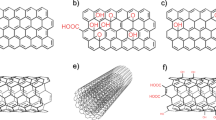Abstract
Plastic films with good robustness and electrical insulation are extensively applied in electrical equipment and electronic devices. However, the reliance on plastics for industrial production and the non-degradability of plastic waste have posed a threat to the environment and human health. Here, a green, sustainable, high-performance composite film has been synthesized to replace petroleum-based plastics by using resource-rich natural wood and mineral synthetic mica as raw materials. The wood scaffold with lamellar structure and oriented channels was obtained through wood nanotechnology, and then the mica sheets were fixed in it by impregnation with mica solution and subsequent mechanical pressing. The resulting Mica/wood films (MWF) exhibited excellent tensile properties (tensile strength of 124.57 MPa and modulus of 11.4 GPa) when the mica addition content was 7.09 wt%, which was better than most plastic films. Meanwhile, the breakdown voltage and thermal stability of MWF were improved with the addition of mica. Additionally, MWF exhibited much lower environmental impact than petrochemical plastic because it easily biodegraded in the soil. This work provided feasible strategy in fabricating environmentally friendly, high-performance bio-based insulating membranes for advanced electrical devices and electronics, demonstrating great potential for addressing resource scarcity and plastic pollution.






Similar content being viewed by others
Data and code availability
Not Applicable.
References
Yim C, Passi V, Lemme MC et al (2018) npj 2D Mater Appl 2:5–11. https://doi.org/10.1038/s41699-018-0051-9
He Z, Gao B, Li T et al (2019) ACS Sustain Chem Eng 7:1745–1752. https://doi.org/10.1021/acssuschemeng.8b05606
Levchenko I, Xu S, Teel G, Mariotti D, Walker MLR, Keidar M (2018) Nat Commun 9:879–885. https://doi.org/10.1038/s41467-017-02269-7
Zhou L, Yang Z, Luo W et al (2016) ACS Appl Mater Interfaces 8:28838–28843. https://doi.org/10.1021/acsami.6b09471
Liu Y, Chen W, Liu H et al (2023) Polym Degrad Stab 209:110264–110271. https://doi.org/10.1016/j.polymdegradstab.2023.110264
Zhang J-W, Cao D-K, Cui Y-C, Wang F, Putson C, Song C (2019) J Clea Prod 208:333–339. https://doi.org/10.1016/j.jclepro.2018.10.057
Hui H, Li Y, Feng Y et al (2022) Polym Adv Technol 33:1685–1694. https://doi.org/10.1002/pat.5631
Jiang B, Chen C, Liang Z et al (2020) Adv Func Mater 30:1906307–1906317. https://doi.org/10.1002/adfm.201906307
Lebreton LCM, van der Zwet J, Damsteeg J-W, Slat B, Andrady A, Reisser J (2017) Nat Commun 8:15611–15620. https://doi.org/10.1038/ncomms15611
Walker S, Rothman R (2020) J Clean Prod 261:121158–121172. https://doi.org/10.1016/j.jclepro.2020.121158
Dong T, Chen W, Cai C et al (2023) Chem Eng J 451:138970–138980. https://doi.org/10.1016/j.cej.2022.138970
Geyer R, Jambeck JR, Law KL (2017) Sci Adv 3:e1700782–1700786. https://doi.org/10.1126/sciadv.1700782
Zhu Z, Wang W, Liu Z et al (2022) Ind Crops Prod 185:115106–115116. https://doi.org/10.1016/j.indcrop.2022.115106
Guan Q-F, Yang H-B, Han Z-M et al (2021) Nano Lett 21:8999–9004. https://doi.org/10.1021/acs.nanolett.1c02315
Lim C, Yusoff S, Ng CG, Lim PE, Ching YC (2021) J Environ Chem Eng 9:105895–105903. https://doi.org/10.1016/j.jece.2021.105895
Mohammed A, Gaduan A, Chaitram P, Pooran A, Lee K-Y, Ward K (2023) Food Hydrocoll 135:108192–107203. https://doi.org/10.1016/j.foodhyd.2022.108192
Chen C, Wu Q, Wan Z et al (2022) Chem Eng J 442:136173–136182. https://doi.org/10.1016/j.cej.2022.136173
Zhou Y, He Y, Lin X, Feng Y, Liu M (2022) ACS Appl Mater Interfaces 14:46980–46993. https://doi.org/10.1021/acsami.2c12764
Kohman GT (1939) Ind Eng Chem 31:807–817. https://doi.org/10.1021/ie50355a005
Hu F, Zeng J, Li J et al (2022) ACS Appl Mater Interfaces 14:14640–14653. https://doi.org/10.1021/acsami.2c01597
Le Bras D, Strømme M, Mihranyan A (2015) J Phys Chem B 119:5911–5917. https://doi.org/10.1021/acs.jpcb.5b00715
Kadumudi FB, Trifol J, Jahanshahi M et al (2020) ACS Appl Mater Interfaces 12:48027–48039. https://doi.org/10.1021/acsami.0c15326
Guan Q-F, Yang H-B, Han Z-M, Ling Z-C, Yu S-H (2020) Nat Commun 11:5401–5407. https://doi.org/10.1038/s41467-020-19174-1
Zinge C, Kandasubramanian B (2020) Eur Polym J133:109758–109776. https://doi.org/10.1016/j.eurpolymj.2020.109758
Sun H, Ji T, Bi H et al (2021) Adv Sustain Sys 5:2100040–2100047. https://doi.org/10.1002/adsu.202100040
Dai J, Fu K, Gong Y et al (2019) ACS Mater Lett 1:354–361. https://doi.org/10.1021/acsmaterialslett.9b00189
Fu Q, Medina L, Li Y, Carosio F, Hajian A, Berglund LA (2017) ACS Appl Mater Interfaces 9:36154–36163. https://doi.org/10.1021/acsami.7b10008
Fu Q, Chen Y, Sorieul M (2020) ACS Nano 14:3528–3538. https://doi.org/10.1021/acsnano.9b09817
Wang M, Li R, Chen G et al (2019) ACS Appl Mater Interfaces 11:14313–14321. https://doi.org/10.1021/acsami.9b00728
Sun H, Ji T, Zhou X et al (2021) Mater Chem Front 5:7903–7909. https://doi.org/10.1039/D1QM00973G
Chen C, Berglund L, Burgert I, Hu L (2021) Adv Mater 33:2006207–2006209. https://doi.org/10.1002/adma.202006207
Jiang F, Li T, Li Y et al (2018) Adv Mater 30:1703453–1703491. https://doi.org/10.1002/adma.201703453
Ji T, Sun H, Cui B et al (2022) Adv Sustain Sys 6:2100382–2100390. https://doi.org/10.1002/adsu.202100382
Sun, H, Bi, H, Lin, X et al (2020), Polymers 12:165–176. https://doi.org/10.3390/polym12010165
Feng Y, He Z, Yang Z, Tang W, Chi Q, Chen Q (2022) J Appl Polym Sci 139:e53034–53043. https://doi.org/10.1002/app.53034
Song J, Chen C, Zhu S et al (2018) Nature 554:224–228. https://doi.org/10.1038/nature25476
Lipton J, Weng GM, Alhabeb M et al (2019) Nanoscale 11:20295–20300. https://doi.org/10.1039/c9nr06015d
Zhao Y, Jiang C, Xiong Y et al (2023) J Mater Sci: Mater Electron 34:330–341. https://doi.org/10.1007/s10854-022-09761-x
Acknowledgement
This work was supported by National Undergraduate Training Programs for Innovations (202110225038). The authors are also thankful to Shiyanjia Laboratory (www.shiyanjia.com) for the breakdown voltage tests.
Author information
Authors and Affiliations
Contributions
TJ contributed to conceptualization, formal analysis, data curation, visualization, writing—original draft, writing—review and editing. KL contributed to methodology, software, investigation, data curation. SC contributed to visualization, investigation. BC contributed to conceptualization, writing—review and editing. MX contributed to conceptualization, resources, funding acquisition, supervision, writing—review and editing.
Corresponding author
Ethics declarations
Conflict of interest
The authors declare that they have no known competing financial interests or personal relationships that could have appeared to influence the work reported in this paper.
Ethical approval
Not applicable.
Additional information
Handling Editor: Stephen Eichhorn.
Publisher's Note
Springer Nature remains neutral with regard to jurisdictional claims in published maps and institutional affiliations.
Supplementary Information
Below is the link to the electronic supplementary material.
Rights and permissions
Springer Nature or its licensor (e.g. a society or other partner) holds exclusive rights to this article under a publishing agreement with the author(s) or other rightsholder(s); author self-archiving of the accepted manuscript version of this article is solely governed by the terms of such publishing agreement and applicable law.
About this article
Cite this article
Ji, T., Li, K., Chen, S. et al. Eco-friendly, mechanically strong, and thermally stable mica/wood electrical insulating film. J Mater Sci 58, 9967–9977 (2023). https://doi.org/10.1007/s10853-023-08531-2
Received:
Accepted:
Published:
Issue Date:
DOI: https://doi.org/10.1007/s10853-023-08531-2




